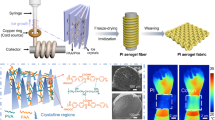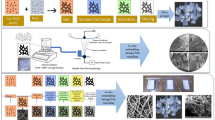Abstract
Excellent thermal insulating materials are highly demanded in various applications including buildings, aerospace and sport equipment. However, in practical applications, the performance of thermal insulating materials usually deteriorates under diverse temperature and humidity conditions. Therefore, it is highly essential to construct a bulk material that exhibits outstanding thermal insulation performance under extremely humid and hot environment. In this work, we have conceived a green and effective strategy to fabricate a superhydrophobic and compressible polyvinylidene fluoride/polyimide (PVDF/PI) nanofiber composite aerogel via electrospinning and freeze-drying technique. Interestingly, the PVDF nanofibers and PI nanofibers function as the hydrophobic fibrous framework and mechanical support skeleton, respectively, forming a robust three-dimensional framework with good mechanical flexibility. The PVDF/PI aerogel possesses outstanding superhydrophobic feature (water contact angle of 152°) and low thermal conductivity (31.0 mW m−1 K−1) at room temperature. Significantly, even at 100% relative humidity (80°C), the PVDF/PI aerogel still exhibits a low thermal conductivity of only 48.6 mW m−1 K−1, which outperforms the majority of commercial thermal insulating materials. Therefore, the novel PVDF/PI aerogel is promising as an excellent thermal insulating material for the applications in high temperature and humid environment.
摘要
优异的隔热材料在建筑、航空航天和体育设备等领域有着 广泛的应用需求. 然而, 在实际应用中, 隔热材料在不同温度和湿度 条件下, 其性能往往会恶化. 因此, 构建在极端湿热环境下仍具有出 色的隔热性能的块状材料是非常重要的. 在本工作中, 我们构思了 一种绿色制备策略, 即通过静电纺丝和冷冻干燥技术来制备超疏 水且可压缩的聚偏氟乙烯/聚酰亚胺(PVDF/PI)纳米纤维复合气凝 胶. PVDF纳米纤维和PI纳米纤维分别充当疏水性纤维骨架和机械 支撑骨架, 形成具有良好机械柔韧性的坚固的三维框架. PVDF/PI 气凝胶在室温下具有出色的超疏水特性(水接触角为152°)和低导 热性(31.0 mW m−1 K−1). 同时, 在100%湿度(80°C)下, PVDF/PI气凝 胶仅显示出48.6 mW m−1 K−1 的低热导率, 其性能优于大多数商业 绝热材料. 因此, 新型的PVDF/PI复合气凝胶有望成为高温和高湿 环境中应用的优良隔热材料.
Similar content being viewed by others
References
Chu S, Majumdar A. Opportunities and challenges for a sustainable energy future. Nature, 2012, 488: 294–303
Schmidt DG. Research opportunities for future energy technologies. ACS Energy Lett, 2016, 1: 244–245
Xu X, Zhang Q, Hao M, et al. Double-negative-index ceramic aerogels for thermal superinsulation. Science, 2019, 363: 723–727
Hu F, Wu S, Sun Y. Hollow-structured materials for thermal insulation. Adv Mater, 2019, 31: 1801001
Zhang L, Deng H, Fu Q. Recent progress on thermal conductive and electrical insulating polymer composites. Compos Commun, 2018, 8: 74–82
Li Y, Liu X, Nie X, et al. Multifunctional organic-inorganic hybrid aerogel for self-cleaning, hea-insulating, and highly efficient microwave absorbing material. Adv Funct Mater, 2019, 29: 1807624
Zhang J, Cheng Y, Tebyetekerwa M, et al. “Stiff-soft” binary synergistic aerogels with superflexibility and high thermal insulation performance. Adv Funct Mater, 2019, 29: 1806407
Ibrahim M, Wurtz E, Biwole PH, et al. Hygrothermal performance of exterior walls covered with aerogel-based insulating rendering. Energy Buildings, 2014, 84: 241–251
Kim NK, Kim K, Payne DA, et al. Fabrication of hollow silica aerogel spheres by a droplet generation method and sol-gel processing. J Vacuum Sci Tech A-Vacuum Surfs Films, 1989, 7: 1181–1184
Si Y, Wang X, Dou L, et al. Ultralight and fire-resistant ceramic nanofibrous aerogels with temperature-invariant superelasticity. Sci Adv, 2018, 4: eaas8925
Zu G, Kanamori K, Wang X, et al. Superelastic triple-network polyorganosiloxane-based aerogels as transparent thermal superinsulators and efficient separators. Chem Mater, 2020, 32: 1595–1604
Zhang X, Zhao X, Xue T, et al. Bidirectional anisotropic polyimide/bacterial cellulose aerogels by freeze-drying for super-thermal insulation. Chem Eng J, 2020, 385: 123963
Guo H, Feng Q, Xu K, et al. Self-templated conversion of metallogel into heterostructured TMP@carbon quasiaerogels boosting bifunctional electrocatalysis. Adv Funct Mater, 2019, 29: 1903660
Guo H, Zhou J, Li Q, et al. Emerging dual-channel transition-metal-oxide quasiaerogels by self-embedded templating. Adv Funct Mater, 2020, 30: 2000024
Fu Y, Wang G, Mei T, et al. Accessible graphene aerogel for efficiently harvesting solar energy. ACS Sustain Chem Eng, 2017, 5: 4665–4671
Hu H, Zhao Z, Wan W, et al. Ultralight and highly compressible graphene aerogels. Adv Mater, 2013, 25: 2219–2223
Chen B, Bi H, Ma Q, et al. Preparation of graphene-MoS2 hybrid aerogels as multifunctional sorbents for water remediation. Sci China Mater, 2017, 60: 1102–1108
Wong JCH, Kaymak H, Brunner S, et al. Mechanical properties of monolithic silica aerogels made from polyethoxydisiloxanes. Microporous Mesoporous Mater, 2014, 183: 23–29
Sun X, Wei Y, Li J, et al. Ultralight conducting PEDOT:PSS/carbon nanotube aerogels doped with silver for thermoelectric materials. Sci China Mater, 2017, 60: 159–166
Mu P, Zhang Z, Bai W, et al. Superwetting monolithic hollow-carbon-nanotubes aerogels with hierarchically nanoporous structure for efficient solar steam generation. Adv Energy Mater, 2019, 9: 1802158
Baskakov SA, Baskakova YV, Kabachkov EN, et al. Novel superhydrophobic aerogel on the base of polytetrafluoroethylene. ACS Appl Mater Interfaces, 2019, 11: 32517–32522
Diascorn N, Calas S, Sallée H, et al. Polyurethane aerogels synthesis for thermal insulation—textural, thermal and mechanical properties. J Supercritical Fluids, 2015, 106: 76–84
Du A, Wang H, Zhou B, et al. Multifunctional silica nanotube aerogels inspired by polar bear hair for light management and thermal insulation. Chem Mater, 2018, 30: 6849–6857
Cahn RW. Strategies to defeat brittleness. Nature, 1988, 332: 112–113
Si Y, Yu J, Tang X, et al. Ultralight nanofibre-assembled cellular aerogels with superelasticity and multifunctionality. Nat Commun, 2014, 5: 5802
Liu Z, Lyu J, Fang D, et al. Nanofibrous Kevlar aerogel threads for thermal insulation in harsh environments. ACS Nano, 2019, 13: 5703–5711
Qian Z, Yang M, Li R, et al. Fire-resistant, ultralight, superelastic and thermally insulated polybenzazole aerogels. J Mater Chem A, 2018, 6: 20769–20777
Cranford SW, Tarakanova A, Pugno NM, et al. Nonlinear material behaviour of spider silk yields robust webs. Nature, 2012, 482: 72–76
Ding Y, Hou H, Zhao Y, et al. Electrospun polyimide nanofibers and their applications. Prog Polym Sci, 2016, 61: 67–103
Xue J, Wu T, Dai Y, et al. Electrospinning and electrospun nanofibers: methods, materials, and applications. Chem Rev, 2019, 119: 5298–5415
Tian J, Shi Y, Fan W, et al. Ditungsten carbide nanoparticles embedded in electrospun carbon nanofiber membranes as flexible and high-performance supercapacitor electrodes. Compos Commun, 2019, 12: 21–25
Zhu J, Lv S, Yang T, et al. Facile and green strategy for designing ultralight, flexible, and multifunctional PVA nanofiber-based aerogels. Adv Sustain Syst, 2020, 4: 1900141
Li Y, Cao L, Yin X, et al. Semi-interpenetrating polymer network biomimetic structure enables superelastic and thermostable nanofibrous aerogels for cascade filtration of PM2.5. Adv Funct Mater, 2020, 30: 1910426
Qian Z, Wang Z, Chen Y, et al. Superelastic and ultralight polyimide aerogels as thermal insulators and particulate air filters. J Mater Chem A, 2018, 6: 828–832
Jiang S, Uch B, Agarwal S, et al. Ultralight, thermally insulating, compressible polyimide fiber assembled sponges. ACS Appl Mater Interfaces, 2017, 9: 32308–32315
Fan W, Zhang X, Zhang Y, et al. Lightweight, strong, and superthermal insulating polyimide composite aerogels under high temperature. Compos Sci Tech, 2019, 173: 47–52
Li X, Yu X, Cheng C, et al. Electrospun superhydrophobic organic/inorganic composite nanofibrous membranes for membrane distillation. ACS Appl Mater Interfaces, 2015, 7: 21919–21930
de Oliveira PB, Godinho M, Zattera AJ. Oils sorption on hydrophobic nanocellulose aerogel obtained from the wood furniture industry waste. Cellulose, 2018, 25: 3105–3119
Zhao Y, Li Y, Zhang R. Silica aerogels having high flexibility and hydrophobicity prepared by sol-gel method. Ceramics Int, 2018, 44: 21262–21268
Zhu J, Hu J, Jiang C, et al. Ultralight, hydrophobic, monolithic konjac glucomannan-silica composite aerogel with thermal insulation and mechanical properties. Carbohydrate Polyms, 2019, 207: 246–255
Madyan OA, Fan M. Hydrophobic clay aerogel composites through the implantation of environmentally friendly water-repellent agents. Macromolecules, 2018, 51: 10113–10120
Zhang X, Wang H, Cai Z, et al. Highly compressible and hydrophobic anisotropic aerogels for selective oil/organic solvent absorption. ACS Sustain Chem Eng, 2018, 7: 332–340
Zhang YG, Zhu YJ, Xiong ZC, et al. Bioinspired ultralight inorganic aerogel for highly efficient air filtration and oil-water separation. ACS Appl Mater Interfaces, 2018, 10: 13019–13027
Shaik S, Talanki Puttaranga Setty AB. Influence of ambient air relative humidity and temperature on thermal properties and unsteady thermal response characteristics of laterite wall houses. Building Environ, 2016, 99: 170–183
Nosrati RH, Berardi U. Hygrothermal characteristics of aerogelenhanced insulating materials under different humidity and temperature conditions. Energy Buildings, 2018, 158: 698–711
Nguyen LH, Beaucour AL, Ortola S, et al. Experimental study on the thermal properties of lightweight aggregate concretes at different moisture contents and ambient temperatures. Construction Building Mater, 2017, 151: 720–731
Alvey JB, Patel J, Stephenson LD. Experimental study on the effects of humidity and temperature on aerogel composite and foam insulations. Energy Buildings, 2017, 144: 358–371
Siwińska A, Garbalińska H. Thermal conductivity coefficient of cement-based mortars as air relative humidity function. Heat Mass Transfer, 2011, 47: 1077–1087
Acknowledgements
The authors are grateful for the financial support from the National Natural Science Foundation of China (21674019 and 21704014), the Fundamental Research Funds for the Central Universities (2232019A3-03), the Graduate Student Innovation Fund of Donghua University (CUSF-DH-D-2019006), Shanghai Sailing Program (17YF1400200), Shanghai Municipal Education Commission (17CG33), and the Ministry of Education of the People's Republic of China (6141A0202202).
Author information
Authors and Affiliations
Contributions
Yang F contributed to the methodology and investigation, and wrote the paper. Zhao X guided the mechanical measurements and contributed to the theoretical analysis. Xue T guided the FT-IR and DSC measurements. Xue T and Yuan S participated in the discussion. Huang Y contributed to the schematic diagrams part. Fan W contributed to the conceptualization, supervision and editing. Liu T contributed to the supervision and editing.
Corresponding authors
Additional information
Conflict of interest
The authors declare no conflict of interest.
Supplementary information
Experimental details and supporting data are available in the online version of the paper.
Fan Yang is a master student of the College of Materials Science and Engineering, Donghua University. She joined Prof. Tianxi Liu's group in 2018 and her research interest is focused on the preparation and properties of nanofiber aerogel materials.
Wei Fan is an associate professor of the College of Materials Science and Engineering, Donghua University. She received her PhD degree in macromolecular chemistry and physics from Fudan University in 2015. Her research interests include functional aerogel composites, polymer nanocomposites and electrochemical energy storage materials.
Tianxi Liu is a professor of the College of Materials Science and Engineering, Donghua University. He received his PhD degree from Changchun Institute of Applied Chemistry, Chinese Academy of Sciences in 1998. His research interests include polymer nanocomposites, new energy materials and devices, hybrid materials, nanofibers and their composite materials.
Supplementary information
40843_2020_1518_MOESM1_ESM.pdf
Superhydrophobic polyvinylidene fluoride/polyimide nanofiber composite aerogels for thermal insulation under extremely humid and hot environment
Rights and permissions
About this article
Cite this article
Yang, F., Zhao, X., Xue, T. et al. Superhydrophobic polyvinylidene fluoride/polyimide nanofiber composite aerogels for thermal insulation under extremely humid and hot environment. Sci. China Mater. 64, 1267–1277 (2021). https://doi.org/10.1007/s40843-020-1518-4
Received:
Accepted:
Published:
Issue Date:
DOI: https://doi.org/10.1007/s40843-020-1518-4




